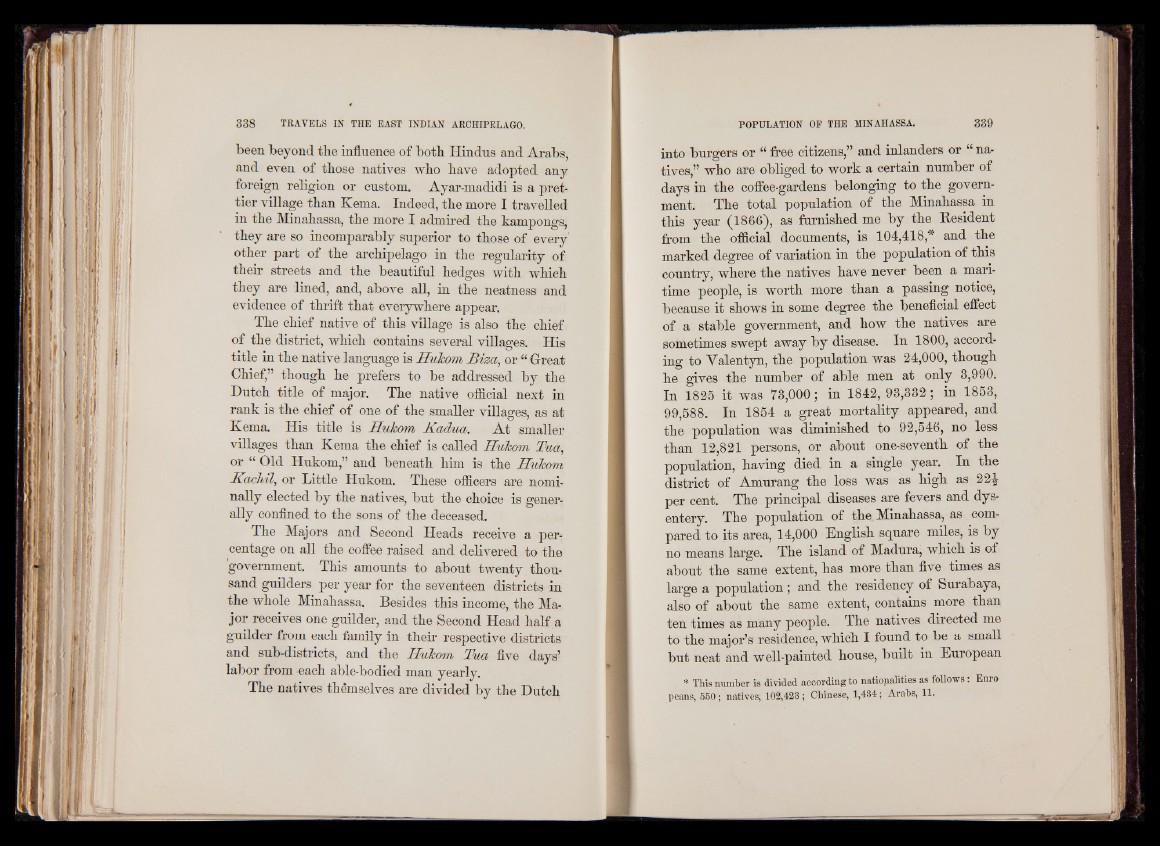
been beyond the influence of both Hindus and Arabs,
and even of those natives who have adopted any
foreign religion or custom. Ayar-madidi is a prettier
village than Kema. Indeed, the more I travelled
in the Minahassa, the more I admired the kampongs,
they are so incomparably superior to those of every'
other part of the archipelago in the regularity of
their streets and the beautiful hedges with which
they are lined, and, above all, in the neatness and
evidence of thrift that everywhere appear.
The chief native of this village is also the chief
of the district, which contains several villages. His
title in the native language is Hukom JBiza, or “ Great
Chief,” though he prefers to be addressed by the
Dutch title of major. The native official next in
rank is the chief of one of the smaller villages, as at 0 7 Kema. His title is Hukom Kadua. At smaller
villages than Kema the chief is called Hukom Tua,
or “ Old Hukom,” and beneath him is the Hukom
Kachil, or Little Hukom. These officers are nominally
elected by the natives, but the choice is generally
confined to the sons of the deceased.
The Majors and Second Heads receive a percentage
on all the coffee raised and delivered to the
government. This amounts to about twenty thousand
guilders per year for the seventeen districts in
the whole Minahassa. Besides this income, the Major
receives one guilder, and the Second Head half a
guilder from each family in their respective districts
and sub-districts, and the Hukom Tua five days’
labor from each able-bodied man yearly.
The natives themselves are divided by the Dutch
into burgers or “ free citizens,” and inlanders or “ natives,”
who are obliged to work a certain number of
days in the coffee-gardens belonging to the government.
The total population of the Minahassa in
this year (1866), as furnished me by the Resident
from the official documents, is 104,418,* and the
marked degree of variation in the population of this
country, where the natives have never been a maritime
people, is worth more than a passing notice,
because it shows in some degree the beneficial effect
of a stable government, and how the natives are
sometimes swept away by disease. In 1800, according
to Valentyn, the population was 24,000, though
he gives the number of able men at only 3,990.
In 1825 it was 73,000; in 1842, 93,332; in 1853,
99,588. In 1854 a great mortality appeared, and
the population was diminished to 92,546, no less
than 12,821 persons, or about one-seventh of the
population, having died in a single year. In the
district of Amurang the loss was as high as 22J
per cent. The principal diseases are fevers and dysentery.
The population of the. Minahassa, as compared
to its area, 14,000 English square miles, is by
no means large. The island of Madura, which is of
about the same extent, has more than five times as
large a population; and the residency of Surabaya,
also of about the same extent, contains more than
ten times as many people. The natives directed me
to the major’s residence, which I found to be a small
but neat and well-painted house, built in European
* This number is divided according to nationalities as follows: Euro
peans, 550; natives, 102,423 ; Chinese, 1,434; Arabs, 11.